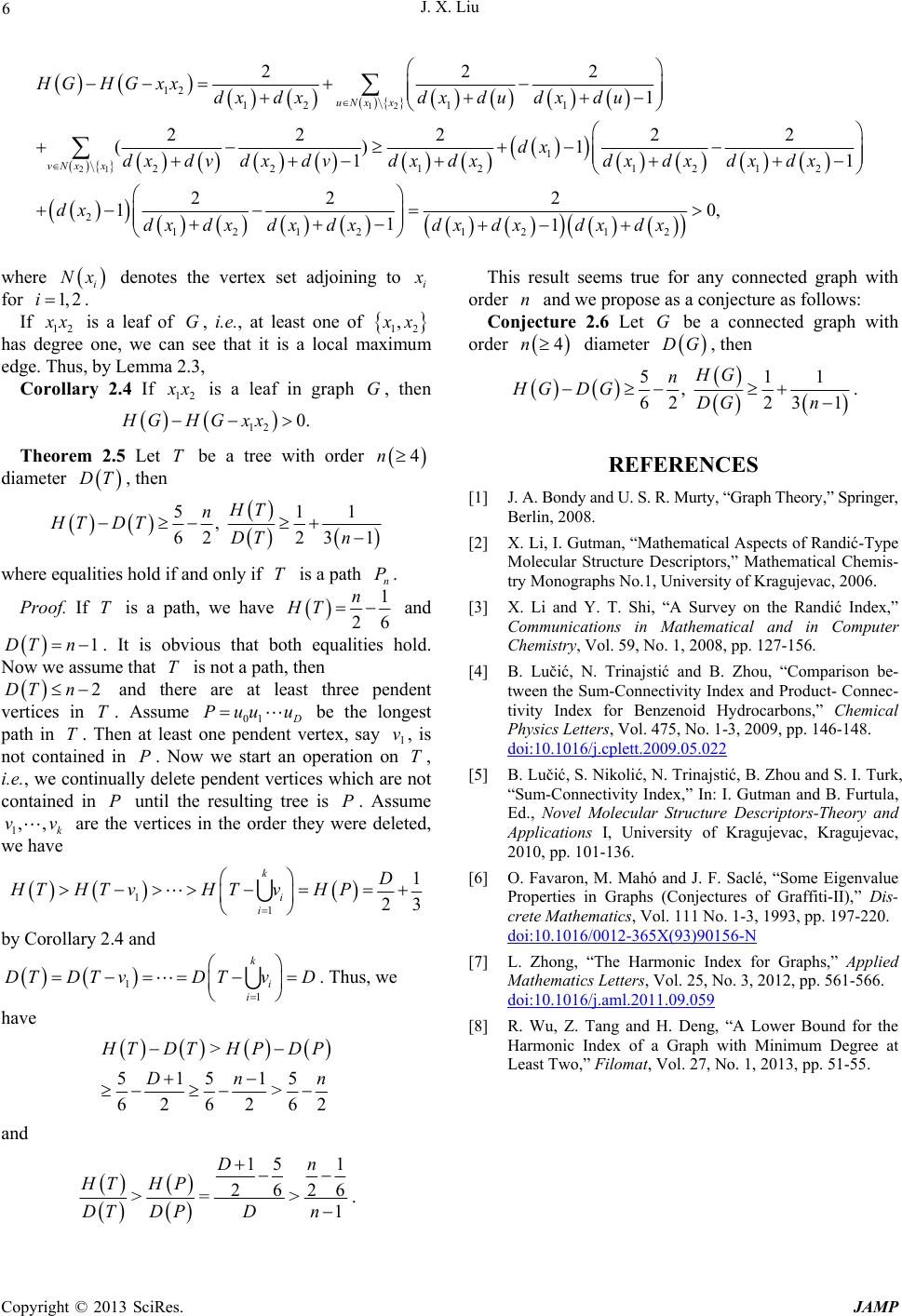
J. X. Liu
6
12
21
12
121 1
1
221212 12
2
12 1212 12
222
1
2222 2
()1
11
22 2
10
11
uNx x
vNx x
HGHG xxdx dxdx dudx du
dx
dxdvdxdvdx dxdx dxdx dx
dx dx dxdx dxdx dxdx dx
,
where denotes the vertex set adjoining to
i
Nx i
for .
1, 2i
If 12
x is a leaf of , i.e., at least one of G
12
,
x
has degree one, we can see that it is a local maximum
edge. Thus, by Lemma 2.3,
Corollary 2.4 If 12
x is a leaf in graph G, then
12 0.HGHG xx
Theorem 2.5 Let T be a tree with order
4n
diameter , then
DT
51
,
6223 1
HT
n
HT DTDT n
1
where equalities hold if and only if
is a path .
n
P
Proof. If is a path, we have
T
1
26
n
HT and
1DT n. It is obvious that both equalities hold.
Now we assume that
is not a path, then
and there are at least three pendent
vertices in
2DT n
. Assume 01
Puu u be the longest
path in
. Then at least one pendent vertex, say 1, is
not contained in
v
. Now we start an operation on
,
i.e., we continually delete pendent vertices which are not
contained in
until the resulting tree is
. Assume
1 are the vertices in the order they were deleted,
we have
,,
k
vv
1
1
1
23
k
i
i
D
HTHT vHTvHP
by Corollary 2.4 and
1
1
k
i
i
DTDT vDTvD
. Thus, we
have
>
51515
>
62 6262
TDTHPDP
Dn
n
and
15 1
2626
>= >
1
Dn
HT HP
DT DPDn
.
This result seems true for any connected graph with
order and we propose as a conjecture as follows:
n
Conjecture 2.6 Let be a connected graph with
order
G
4n diameter , then
DG
51
,
6223 1
HG
n
HG DGDG n
1
.
REFERENCES
[1] J. A. Bondy and U. S. R. Murty, “Graph Theory,” Springer,
Berlin, 2008.
[2] X. Li, I. Gutman, “Mathematical Aspects of Randić-Type
Molecular Structure Descriptors,” Mathematical Chemis-
try Monographs No.1, University of Kragujevac, 2006.
[3] X. Li and Y. T. Shi, “A Survey on the Randić Index,”
Communications in Mathematical and in Computer
Chemistry, Vol. 59, No. 1, 2008, pp. 127-156.
[4] B. Lučić, N. Trinajstić and B. Zhou, “Comparison be-
tween the Sum-Connectivity Index and Product- Connec-
tivity Index for Benzenoid Hydrocarbons,” Chemical
Physics Letters, Vol. 475, No. 1-3, 2009, pp. 146-148.
doi:10.1016/j.cplett.2009.05.022
[5] B. Lučić, S. Nikolić, N. Trinajstić, B. Zhou and S. I. Turk,
“Sum-Connectivity Index,” In: I. Gutman and B. Furtula,
Ed., Novel Molecular Structure Descriptors-Theory and
Applications I, University of Kragujevac, Kragujevac,
2010, pp. 101-136.
[6] O. Favaron, M. Mahó and J. F. Saclé, “Some Eigenvalue
Properties in Graphs (Conjectures of Graffiti-II),” Dis-
crete Mathematics, Vol. 111 No. 1-3, 1993, pp. 197-220.
doi:10.1016/0012-365X(93)90156-N
[7] L. Zhong, “The Harmonic Index for Graphs,” Applied
Mathematics Letters, Vol. 25, No. 3, 2012, pp. 561-566.
doi:10.1016/j.aml.2011.09.059
[8] R. Wu, Z. Tang and H. Deng, “A Lower Bound for the
Harmonic Index of a Graph with Minimum Degree at
Least Two,” Filomat, Vol. 27, No. 1, 2013, pp. 51-55.
Copyright © 2013 SciRes. JAMP